Sarawak Excelsa coffee stands out with its rich and complex flavor profile, featuring intriguing notes of dry cocoa, peanut butter, and hints of maple syrup alongside fruity undertones like cranberry. This exotic brew is cultivated in Sarawak’s highlands, where indigenous farming practices thrive. Excelsa is often confused with Arabica due to its unique characteristics but delivers a surprising experience for those seeking diverse coffee options. With a higher yield than Liberica, it’s becoming increasingly popular among coffee enthusiasts. If you’re curious about its cultivation challenges and the ongoing research efforts, there’s more to explore.
What Types of Coffee Are Grown in Sarawak?
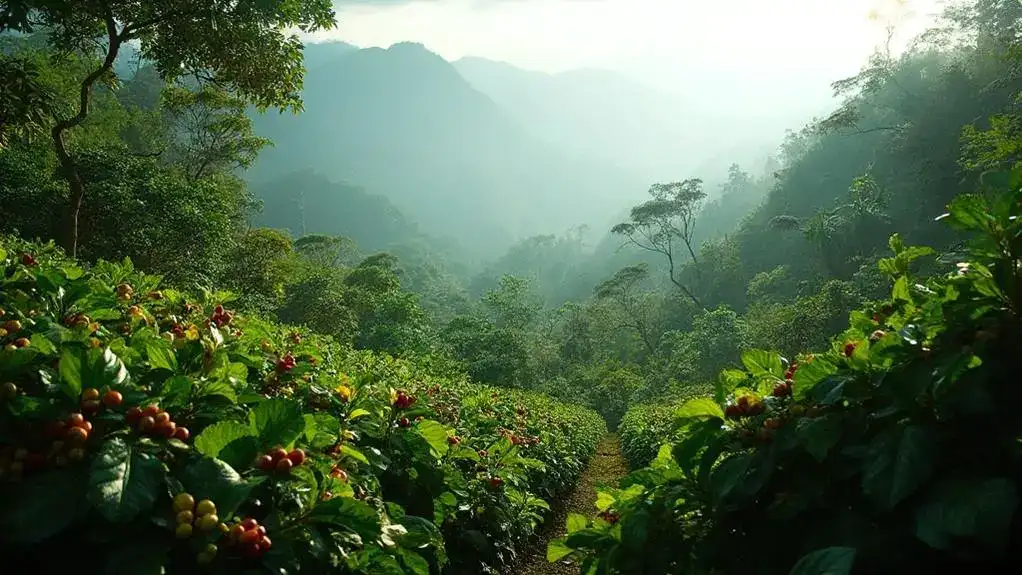
In Sarawak, you’ll find two main coffee varieties being cultivated: Liberica and Excelsa.
These unique types thrive in the region’s highlands, where local indigenous communities have been growing them for generations.
Understanding these varieties can deepen your appreciation for Sarawak’s rich coffee culture.
What Coffee Varieties Are Cultivated in Sarawak?
When exploring the coffee landscape of Sarawak, you’ll find that two main varieties dominate the highlands: Liberica and Excelsa.
Both types are cultivated by local farmers, each contributing uniquely to Sarawak’s coffee culture.
Here are some key points about these varieties:
- Liberica coffee is grown in Sarawak’s highlands.
- Excelsa coffee is also cultivated in the region.
- Both varieties face challenges in productivity.
- Indigenous communities play a role in their cultivation.
- Excelsa is often mistaken for Arabica by local farmers.
Is Liberica Coffee Grown in Sarawak?
Have you ever wondered about the coffee varieties thriving in Sarawak? Yes, Liberica coffee is indeed grown here, especially in the highlands.
This variety faces challenges like low productivity and high cultivation costs, but local farmers are dedicated to its growth.
Emphasizing Liberica cultivation enhances coffee sustainability, ensuring these communities can maintain their unique coffee culture while contributing to environmental health.
Is Excelsa Coffee Grown in Sarawak?
Excelsa coffee is also cultivated in Sarawak, particularly in the highlands where local farmers often confuse it with Arabica.
This unique variety thrives through indigenous farming practices, contributing to the region’s diverse coffee culture.
Excelsa cultivation offers a distinct flavor profile, making it a valuable crop for local farmers.
Understanding these nuances can enhance appreciation for Sarawak’s rich coffee heritage.
How Do Liberica and Excelsa Coffee Varieties Differ?

When comparing Liberica and Excelsa coffee varieties, you’ll notice key differences in their seed shapes, sizes, and flavor profiles.
Excelsa often surprises with its complex and intense flavors, making it distinct from the milder Liberica.
Understanding these differences can enhance your appreciation for each variety’s unique characteristics.
What Are the Differences Between Liberica and Excelsa Coffee?
When you’re exploring the differences between Liberica and Excelsa coffee, you’ll notice some key distinctions in their characteristics.
These differences can be observed in aspects such as seed shape, size, and classification. Here are some points to take into account:
- Liberica seeds are generally larger and more elongated.
- Excelsa seeds are smaller and have a different shape.
- Excelsa is classified as a variety of Liberica.
- Morphological traits vary greatly between the two.
- Flavor profiles also differ, with Excelsa often being more complex.
How Do the Seed Shape and Size of Liberica and Excelsa Differ?
In the domain of coffee cultivation, the seed shape and size of Liberica and Excelsa varieties present notable differences that affect their classification and characteristics. Liberica seeds are larger and more irregular, while Excelsa seeds are generally smaller and more oval-shaped. Understanding these seed characteristics and morphological differences is essential for recognizing the unique identities of each coffee variety.
| Variety | Seed Shape | Seed Size |
|---|---|---|
| Liberica | Irregular | Larger |
| Excelsa | Oval | Smaller |
How Are Liberica and Excelsa Classified?
Classifying Liberica and Excelsa coffee varieties can be quite complex due to their unique characteristics.
In coffee taxonomy, Liberica and Excelsa are differentiated based on classification criteria like seed shape, size, and morphological traits.
While Excelsa was once seen as a separate species, it’s now recognized as a variety of Liberica, highlighting their close relationship yet distinct differences in flavor and appearance.
What Is the Flavour Profile of Sarawak Excelsa Coffee?
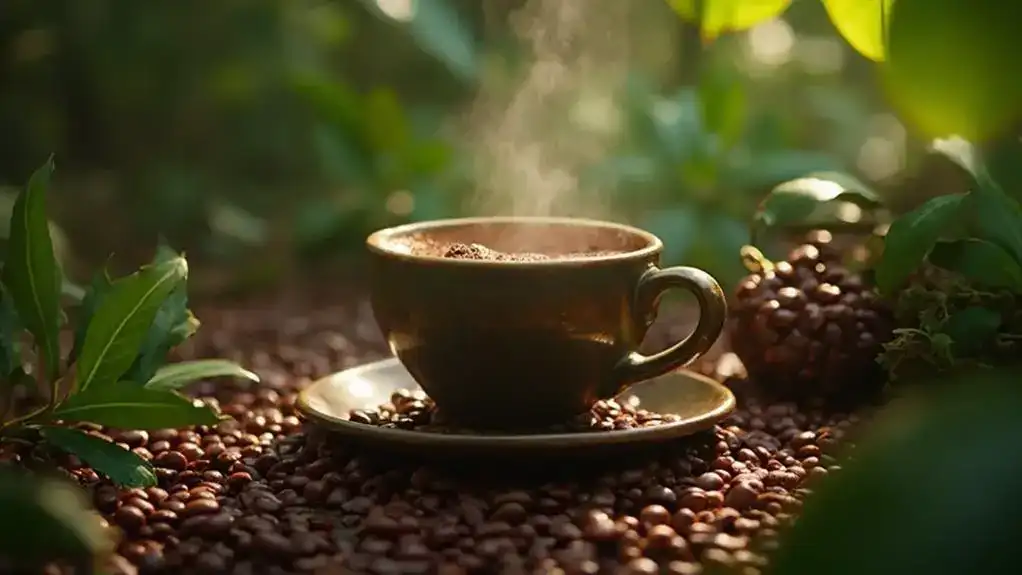
When you taste Sarawak Excelsa coffee, you’ll notice a rich and complex flavor profile that sets it apart.
Expect tasting notes of dry cocoa and peanut butter, with some samples revealing hints of maple syrup and fruit undertones like cranberry and fig.
This diverse flavor experience makes Sarawak Excelsa a unique choice for coffee enthusiasts.
What Tasting Notes Are Found in Sarawak Excelsa Coffee?
When you taste Sarawak Excelsa coffee, you’ll notice its unique and complex flavor profile.
This variety stands out with tasting notes that include:
- Dry cocoa
- Peanut butter
- Maple syrup
- Cranberry
- Fig and plum undertones
These elements come together to create a rich coffee experience unlike any other.
Excelsa Coffee Notes of Dry Cocoa and Peanut Butter
The distinct flavor notes of Sarawak Excelsa coffee make it a remarkable experience for coffee enthusiasts.
You’ll discover intriguing dry cocoa flavors that add depth to each sip, complemented by rich peanut butter undertones.
This combination creates a unique profile that sets Sarawak Excelsa apart from other varieties, making it a must-try for those seeking a complex and satisfying coffee experience.
Excelsa Coffee Maple Syrup and Fruit Undertones
Sarawak Excelsa coffee’s flavor profile surprises with its delightful notes of maple syrup and a medley of fruit undertones.
When using excelsa brewing techniques, you’ll discover how these flavors harmonize beautifully.
Pairing it with chocolate or nutty desserts enhances the experience, showcasing excelsa flavor pairings.
This complexity makes Sarawak Excelsa a unique choice for coffee enthusiasts seeking an adventurous cup.
Flavour Variations in Excelsa Coffee from Southern Sudan
Exploring the flavor variations in Excelsa coffee from Southern Sudan reveals a fascinating contrast to its Sarawak counterpart.
The flavour influences from different coffee origins contribute to these unique profiles, which may include:
- Creamy chocolate
- Bright fruity notes
- Subtle spice undertones
- Earthy richness
- Floral hints
These variations highlight how geography shapes coffee’s taste, enhancing your appreciation for this exotic brew.
How Does the Yield of Excelsa Coffee Compare to Liberica?
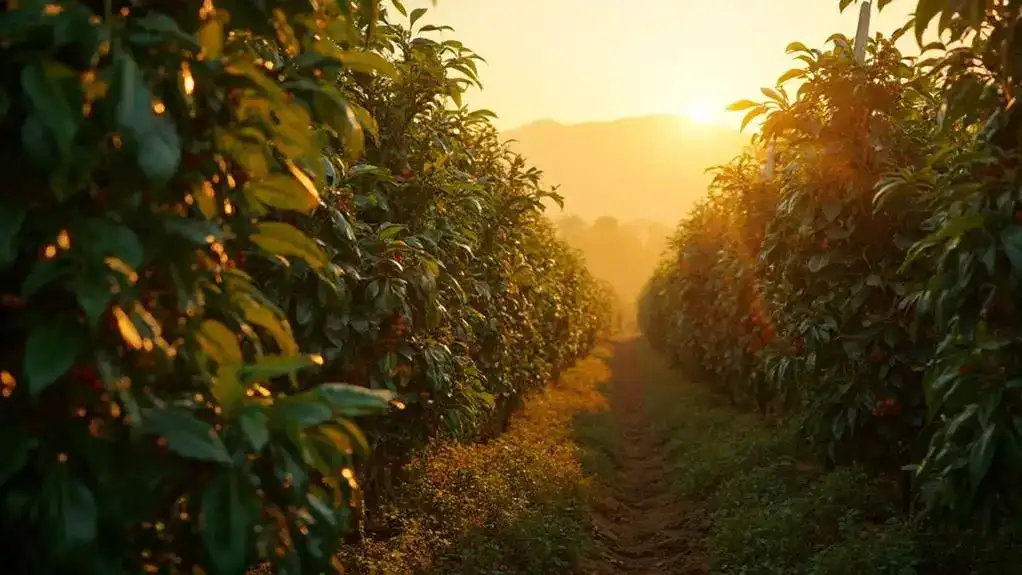
When it comes to coffee yields, Excelsa coffee stands out as more productive than Liberica.
With an average yield of around 11%, Excelsa offers farmers a more viable crop option compared to Liberica’s 7%.
This higher productivity makes Excelsa an appealing choice for those cultivating coffee in Sarawak.
Is Excelsa Coffee More Productive Than Liberica?
When comparing the productivity of Excelsa and Liberica coffee, you’ll notice some key differences in their yields.
Excelsa coffee boasts an average yield of about 11%, while Liberica lags behind at around 7%.
Here’s a quick look at these stats:
- Average Yield of Excelsa Coffee: 11%
- Average Yield of Liberica Coffee: 7%
Productivity Impact on Farmers: Higher yields can lead to better profits.
Cultivation Viability: Excelsa may be a more practical choice for local farmers.
Market Potential: With better yields, Excelsa coffee could attract more interest in the market.
What Is the Average Yield of Liberica Coffee?
The average yield of Liberica coffee in Sarawak stands at approximately 7%, which poses challenges for local farmers aiming for profitability. This lower yield compared to other varieties highlights the need for better coffee education and practices in Liberica cultivation.
| Coffee Variety | Average Yield | Challenges |
|---|---|---|
| Liberica | 7% | Low profitability |
| Excelsa | ||
| Arabica |
What Is the Average Yield of Excelsa Coffee?
Excelsa coffee boasts an impressive average yield of around 11%, making it a more productive choice for farmers in Sarawak compared to Liberica, which only yields about 7%. Below is a yield comparison between the two coffee varieties:
| Coffee Variety | Average Yield |
|---|---|
| Excelsa | 11% |
| Liberica | 7% |
What Were the Results of Recent Cupping Sessions in Kuching?
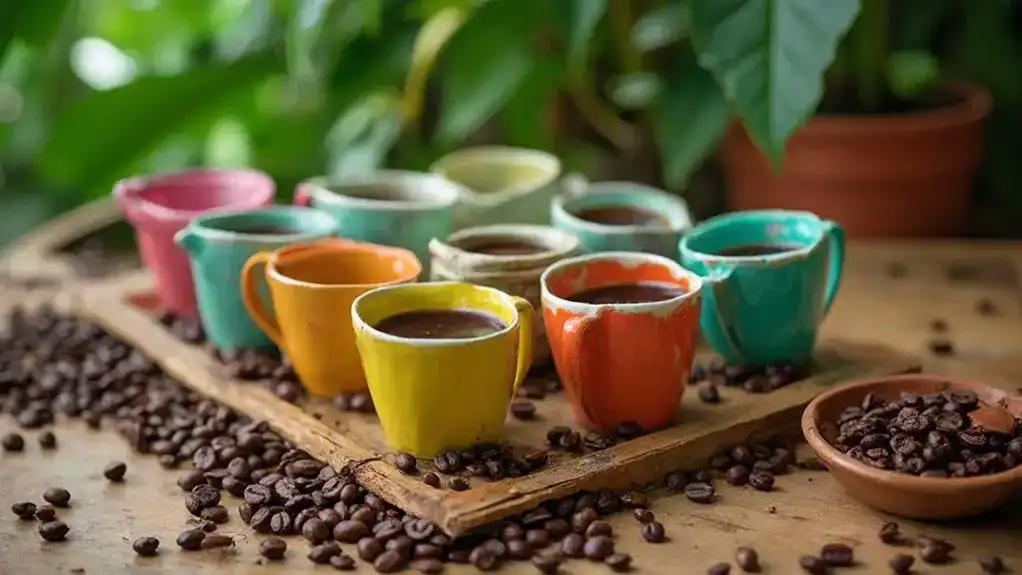
In the recent cupping sessions in Kuching, you’ll find that Excelsa coffee showcased a distinct flavor profile that set it apart from various Liberica samples.
These sessions revealed that Excelsa offered a more complex and richer taste, which impressed many participants.
As a result, the unique qualities of Excelsa coffee are gaining recognition in the local coffee scene.
What Flavour Differences Were Found in Cupping Sessions?
In recent cupping sessions in Kuching, you’ll find that the flavor profiles of various Liberica samples differ considerably, with Excelsa coffee leading the way regarding intensity and complexity.
The results highlighted not only the unique attributes of Excelsa but also how it outperformed its Liberica counterparts.
Here are some key findings from the sessions:
- Excelsa exhibited a richer flavor profile.
- Liberica samples showed a range of flavors but less complexity.
- Excelsa’s notes included dry cocoa and fruit undertones.
- The overall quality of Excelsa was rated higher.
- Cupping results reinforced the distinctiveness of Excelsa coffee.
What Were the Findings from Testing Various Liberica Samples?
Recent cupping sessions in Kuching revealed captivating insights into the flavor profiles of various Liberica coffee samples.
You’d notice that the Liberica flavors varied considerably, showcasing a range of earthy and fruity notes.
Curiously, Excelsa cultivation produced samples with a more pronounced complexity, highlighting the unique characteristics of this variety compared to traditional Liberica, which tended to display more subdued flavors.
How Did Excelsa Coffee Perform in the Cupping Sessions?
Excelsa coffee truly shone during the cupping sessions, impressing tasters with its rich and complex flavor profile.
Utilizing precise cupping techniques, participants noted distinct differences:
- Intense cocoa notes
- Subtle hints of peanut butter
- Sweet maple syrup undertones
- Fruity accents like cranberry and fig
- A well-rounded mouthfeel
These findings highlight the unique Excelsa flavor, setting it apart from other varieties in Kuching.
What Are the Challenges in Cultivating Sarawak Excelsa Coffee?
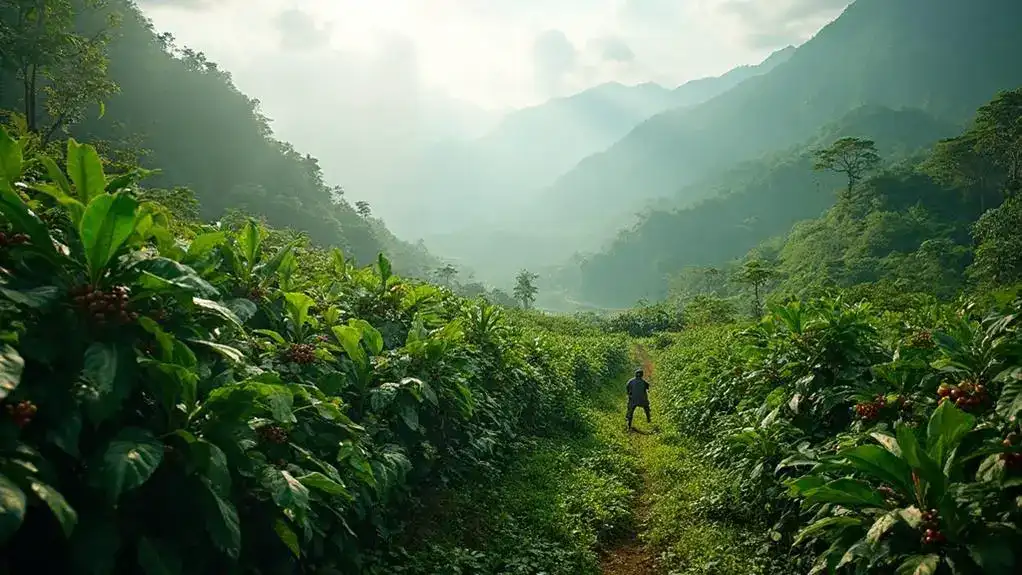
Cultivating Sarawak’s Excelsa coffee presents several challenges that farmers must navigate for successful production. One of the primary obstacles is mastering the right cultivation techniques. Excelsa coffee requires specific growing conditions, including suitable soil types and adequate rainfall, which can be unpredictable.
Farmers often face difficulties in maintaining these conditions, impacting their yield and quality. Moreover, high cultivation costs can deter new farmers from entering the market. Investing in proper tools, fertilizers, and pest control measures is essential but can be burdensome financially.
This leads to a reliance on traditional farming practices that may not yield the best results. Market challenges also pose significant issues. There’s a limited understanding and acceptance of Excelsa coffee among consumers. Many may confuse it with more popular varieties like Arabica, leading to lower demand.
Without robust marketing strategies to educate consumers about the unique qualities of Excelsa coffee, farmers struggle to secure a profitable market. Together, these challenges can hinder the growth of Sarawak’s Excelsa coffee industry, requiring farmers to adapt and innovate continually to thrive in a competitive landscape.
What Misconceptions Do Indigenous Farmers Have About Coffee in Sarawak?
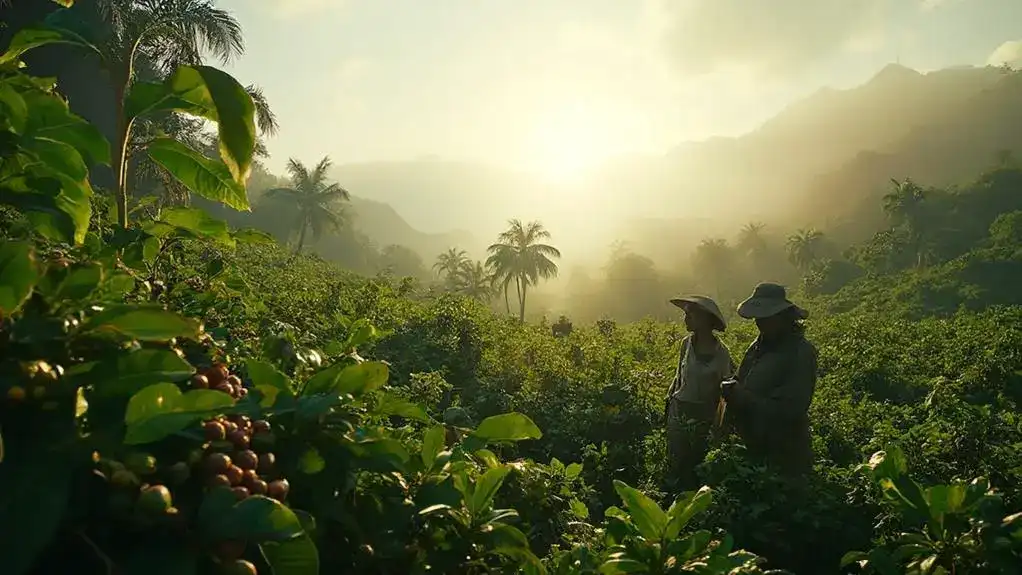
Many indigenous farmers in Sarawak mistakenly believe they’re cultivating Arabica coffee when, in fact, they’re growing Liberica and Excelsa varieties.
This confusion can lead to mismanagement of their crops and hinder their potential yields.
Understanding the differences between these coffee types is essential for improving farming practices and maximizing productivity.
Common Misunderstandings About Coffee Types Among Farmers
Many indigenous farmers in Sarawak mistakenly think they’re growing Arabica coffee when it’s actually Liberica or Excelsa. This confusion not only affects their farming practices but also highlights the need for better education about these coffee types.
Here are some key reasons why understanding coffee varieties is essential:
- Farmers often misidentify coffee types, impacting cultivation methods.
- Misconceptions can lead to poor market strategies.
- Correct identification can enhance crop management.
- Education can improve overall yield and quality.
- Awareness of coffee diversity can open new market opportunities.
Do Farmers Confuse Arabica with Liberica and Excelsa?
A surprising number of farmers in Sarawak mistakenly identify Excelsa and Liberica coffee as Arabica.
This misunderstanding stems from a lack of proper coffee education and inadequate farmer training.
Many local farmers believe they’re cultivating Arabica, leading to confusion about the characteristics and management of their crops.
Addressing these misconceptions through targeted education is essential for improving farming practices and overall coffee quality.
Why Is There a Need for Better Education on Coffee Types?
Understanding the distinctions between coffee types is essential for Sarawak’s farmers, as misconceptions can lead to mismanagement of crops.
Many local farmers mistakenly believe they’re cultivating Arabica when they’re actually growing Liberica or Excelsa. This highlights the need for enhanced coffee education and farmer training.
What Research Is Being Conducted on Sarawak’s Excelsa Coffee?
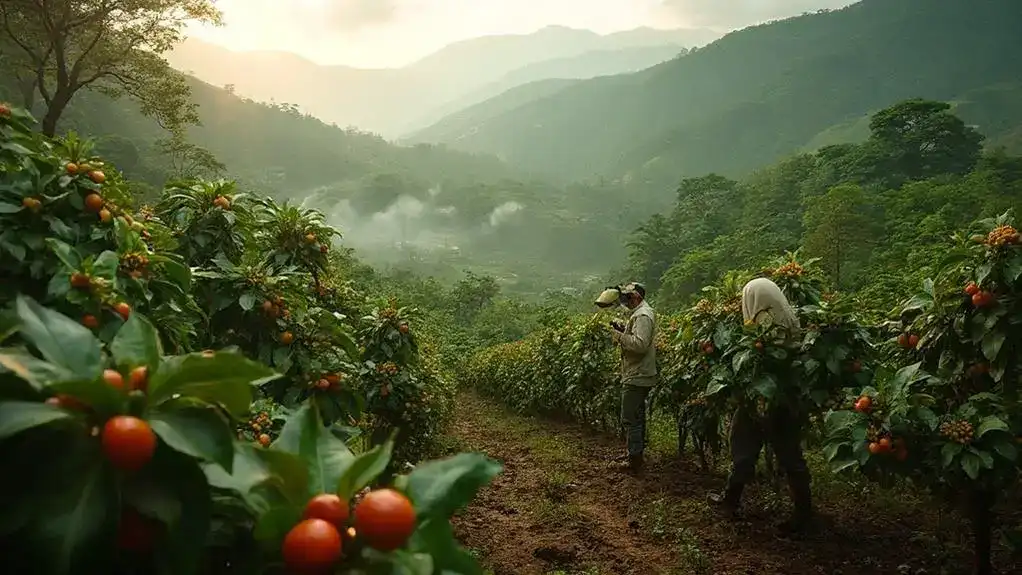
Research on Sarawak’s Excelsa coffee is currently focused on uncovering new varieties that could enhance both flavor and yield.
Scientists are exploring the highlands of Borneo to identify undiscovered strains of Excelsa and Liberica coffee.
These efforts aim to boost productivity and improve the overall quality of coffee produced in the region.
What Are the Current Research Efforts on Excelsa Coffee?
Research on Sarawak’s Excelsa coffee is uncovering exciting possibilities for undiscovered varieties that could elevate local production.
You’ll find that the Borneo highlands play an essential role in these efforts, aiming to enhance yield and flavor.
Here are some key points to take into account:
- Potential for new flavors and higher productivity
- Focus on developing unique Excelsa varieties
- Contribution of local indigenous knowledge to research
- Collaboration with agricultural experts and universities
- Importance of preserving biodiversity in coffee cultivation
What Potential Exists in Undiscovered Varieties of Excelsa?
Exploring the uncharted potential of undiscovered Excelsa coffee varieties can greatly enhance Sarawak’s coffee landscape.
Research is focusing on the genetic diversity of these varieties, which may reveal new potential flavors that could appeal to coffee enthusiasts.
How Is Borneo Highlands Contributing to Coffee Research?
The highlands of Borneo play a pivotal role in advancing coffee research, particularly concerning the Excelsa variety.
Ongoing research focuses on improving coffee cultivation methods and identifying new Excelsa varieties. With increasing research funding, scientists aim to enhance flavor profiles and yields, benefiting local farmers.
This work not only supports the coffee industry but also promotes sustainable agricultural practices in the region.
Conclusion
To conclude, Sarawak Excelsa coffee offers a unique tasting experience that sets it apart from more common varieties. Curiously, while Liberica coffee has a yield of about 1,200 kg per hectare, Excelsa’s yield is slightly lower at around 800 kg per hectare, highlighting the challenges local farmers face. Continued research and cultivation efforts are essential to enhance the production of this distinctive coffee. By exploring its complexities, you’ll gain a deeper appreciation for Sarawak’s rich coffee culture.

